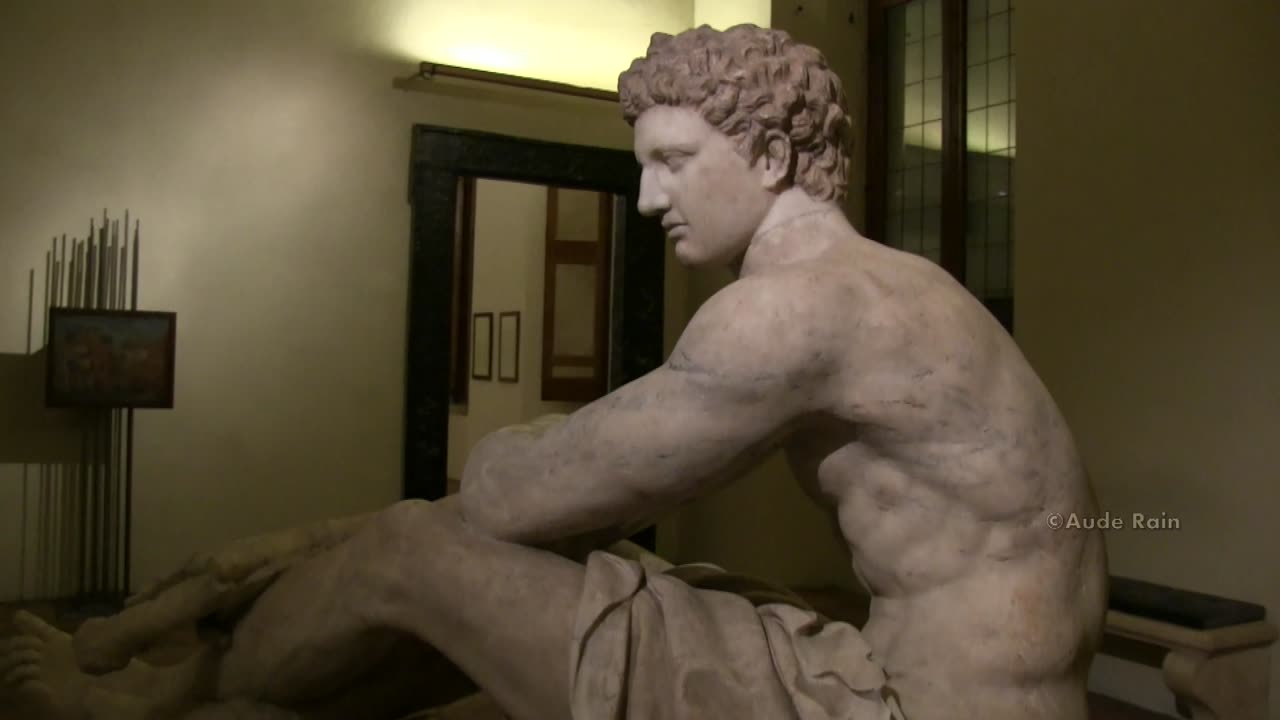Premium Only Content

Guerriero seduto & Ares Ludovisi
Young warrior sitting on the ground, pendant of the Ares Ludovisi. Pentelic marble (body) and Parian marble (head), Roman copy from a Hellenistic original. Some restorations; the head (of the type of Meleager of Skopas) is ancient, but does not belong to the body.
Ares Ludovisi
Realization: 200 BC
"It is a Roman copy of a Greek original attributed to Scopas or Lysippus dating back to around 320 BC. The identification of the figure, traditionally considered the god of war, remains doubtful. Recently the hypothesis has been put forward that it is Achilles. The man is seated with his weapons laid down: he rests his left foot on his helmet, while his shield rests on his right leg. Found in 1622, it owes part of its fame to the restoration by Gian Lorenzo Bernini who, among other interventions, added the little cupid at the bottom.
The famous archaeologist Winckelmann defined the statue as "the most beautiful Mars of antiquity"."
Filmed at Palazzo Altemps and at the Galleria Borghese in Rome.
Giovane guerriero seduto a terra, pendant dell'Ares Ludovisi. Marmo pentelico (corpo) e marmo pario (capo), copia romana da un originale ellenistico. Alcuni restauri; la testa (del tipo del Meleagro di Skopas) è antica, ma non appartiene al corpo.
Ares Ludovisi
Realizzazione: 200 a.C.
È una copia romana di un originale greco attribuito a Scopa o a Lisippo databile intorno al 320 a.C. Resta dubbia l’identificazione della figura, tradizionalmente considerata il dio della guerra. Recentemente è stata avanzata l’ipotesi si tratti di Achille. L’uomo è seduto e con le armi deposte: poggia il piede sinistro sul suo elmo, mentre sulla gamba destra è poggiato il suo scudo. Rinvenuto nel 1622, deve parte della sua fama al restauro di Gian Lorenzo Bernini che, tra gli altri interventi, aggiunse il piccolo amorino in basso.
Il celebre archeologo WInckelmann defini la statua «il più bel Marte dell’antichità».
-
 LIVE
LIVE
In The Litter Box w/ Jewels & Catturd
21 hours agoLegacy media CANNOT be trusted | In the Litter Box w/ Jewels & Catturd – Ep. 697 – 11/22/2024
6,154 watching -
 1:22:02
1:22:02
The Quartering
2 hours agoTrump BEATS NYC Felony Charges, New Woke Car Ads, WW3 Updates & More
59K34 -
 10:03
10:03
Colion Noir
3 hours agoKimber's First "True" Double Stack 1911 Isn't Just A Gun It's A Statement
9.45K9 -
 1:46:28
1:46:28
vivafrei
6 hours agoKeir Starmer Goes Full Tyrant! Canada Goes Full Gestapo! Trump Picks & MORE! Viva Frei Live
67.8K23 -
 LIVE
LIVE
ThatWhiteFish (Gaming)
2 hours ago $3.02 earnedNew to the Franchise! Can we survive? Do you have rations?
431 watching -
 1:10:50
1:10:50
The New American
2 hours agoIs The Deep State Trying to Trigger WW3 Before Trump Takes Office? | The New American Daily
13.9K7 -
 51:36
51:36
PMG
14 hours ago $4.10 earned"Hannah Faulkner and Sophia Lorey | FIRST AMENDMENT VIOLATED"
27K5 -
 LIVE
LIVE
Flexarot
3 hours agoGetting The Bansho Fan & Crane Level Capped! (Dragon Ball Online Galaxy)
131 watching -
 1:17:57
1:17:57
Russell Brand
4 hours agoLara Logan EXPOSES the Media's Hidden Agendas & Power Plays – SF499
125K184 -
![WELCOME :] | !GUILDED](https://1a-1791.com/video/s8/1/J/m/y/0/Jmy0u.0kob-small-Slammin-Apex-clams-GUILDED.jpg) LIVE
LIVE
checkmate7_7
9 hours ago $3.16 earnedWELCOME :] | !GUILDED
220 watching